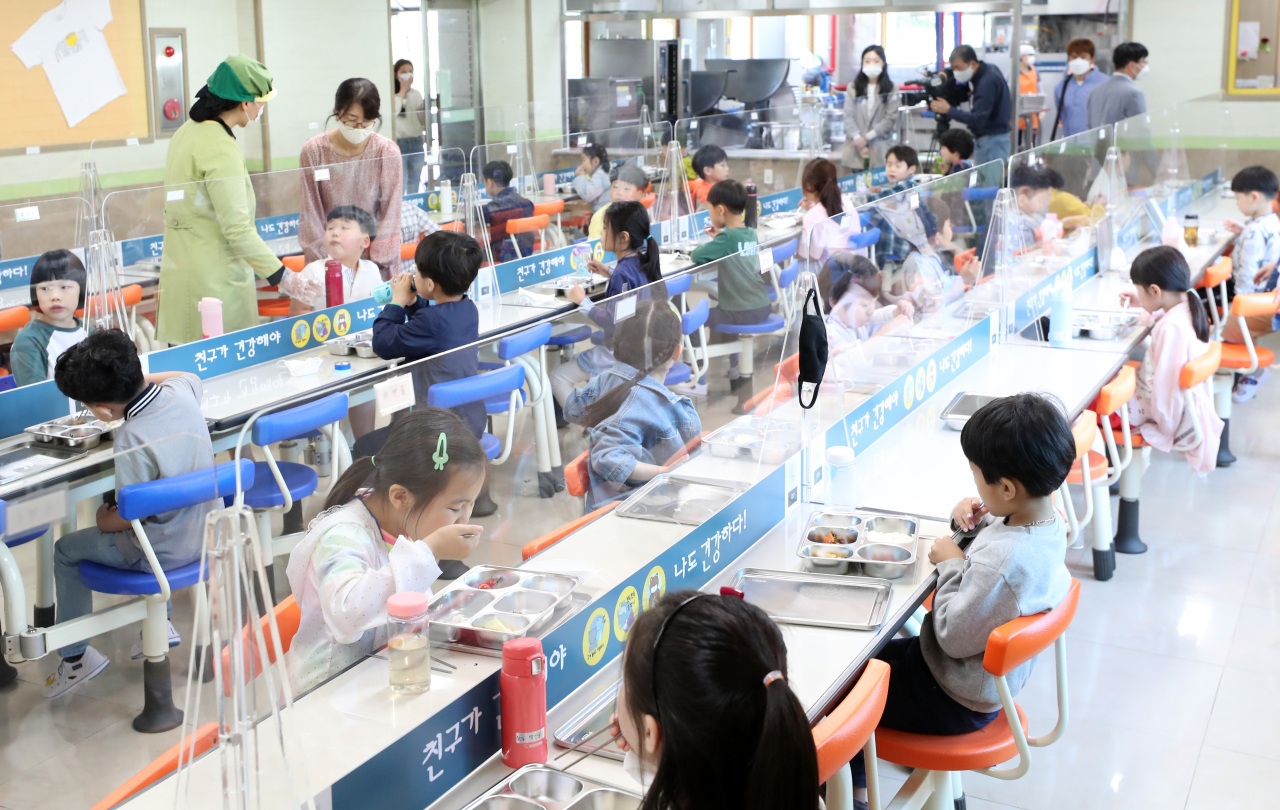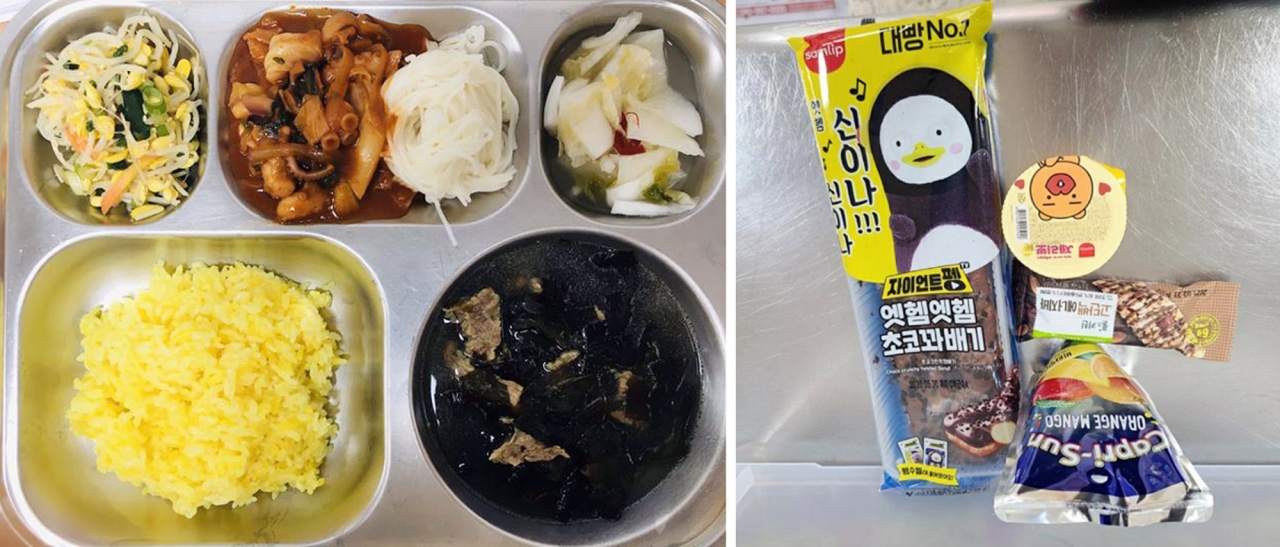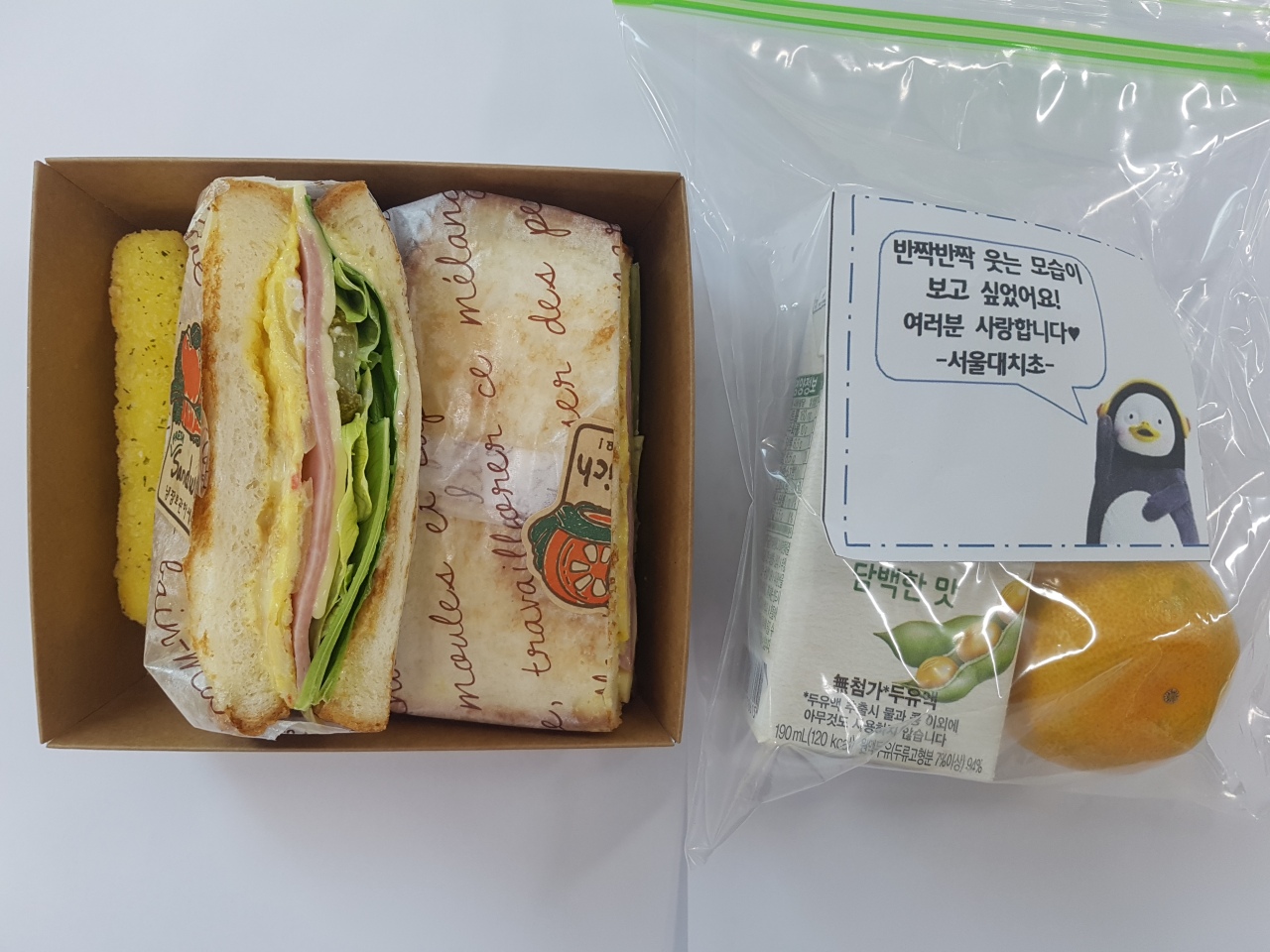 |
Elementary school students eat lunch while seated in a zigzag configuration with partitions at the tables. (Yonhap) |
As students returned to schools wearing masks, changes to the school lunch system were inevitable to ensure the safety of students from COVID-19.
Since the coronavirus can be transmitted through saliva, students were considered most vulnerable during lunch when they took off masks to eat. As such, many measures have been taken by schools under the central government’s instructions.
Many schools have installed individual partitions in classrooms and cafeterias. Doors to dining halls are being left open so students do not touch door knobs, and utensils are being handed out by kitchen staff wearing disposable gloves.
“I think while the Korean government was getting lots of praise around the world regarding its handling of COVID-19, schools responded quickly to the COVID-19 situation in relation to school meals. One of the major reasons Korean schools were able to do so is that Korean schools are managed by a central government, the Ministry of Education, which can put schools in the uniformed communication and practices,” Ham Seon-ok, professor of food and nutrition at the College of Human Ecology at Yonsei University, told The Korea Herald. Ham specializes in the study of food services operation and management.
Although experts had suggested not providing school meals to prevent mass infections, schools and the Ministry of Education could not ignore parent opposition and growing economic losses for farmers as agricultural products for school meals went to waste with the prolonged closure of schools.
Meanwhile, bringing lunch from home was not considered an option as many parents felt schools were responsible for providing food. In 2011, Seoul made school lunch free to all elementary students, before extending the program to all middle schools in 2014.
Some schools have made changes to where meals are served, for instance, having students eat in classrooms as dining halls often do not have enough space to accommodate all students while maintaining social distancing. This way, waiting in line in the dining hall, which can lead to infection, can also be avoided. Schools that lacked the infrastructure to allow students to eat in classrooms set partitions on dining hall tables and made students sit facing one direction, one seat apart or in a zigzag configuration so as not to sit across from each other.
“According to the kids, they can’t even talk among themselves and are only allowed to eat and leave,” said one worried mother of a first grader. “I can’t say remove the partitions as some parents are taking their kids home for lunch in fear of getting infected. I think partitions are necessary, but at the same time feel sorry for the kids. Lunch used to be the most anticipated hour during our childhood. ... I hope this situation ends soon.”
 |
Lunch before the novel coronavirus (left) and post-coronavirus (Yonhap) |
Along with spatial changes at lunch time, menus and food preparation have been altered in order to prevent the spread of the new coronavirus.
The food preparation process was reexamined in order to minimize the amount of time people cooking are in contact with the food and to minimize the number of people involved in the cooking process. Also, education about sanitization procedures as well as the health screening of people involved in cooking school lunches have become stricter than ever before.
“In order to minimize the amount of contact with people during distribution, convenience foods like sandwiches or one-dish meals can be given as well as alternative meals like bread and milk,” said Ham.
Many schools removed soups from their menu for a few weeks to accommodate eating in the class and gave out bowls of rice or rice balls, while reducing the number of side dishes.
 |
Convenience food is given to students in an elementary school in Seoul. (Daechi Elementary School) |
The government has relaxed some regulations regarding school meals in order to ensure safety of students. Nutritional standards have been temporarily relaxed, allowing meals like sandwiches and rice balls to be given along with relaxation of environmental standards to allow use of plastic utensils and disposables like plastic gloves and paper cups.
Another possible problem that can arise from new school lunch measures is the lack of social interaction stemming from the use of partitions. Some schools have gone as far as banning talking during lunch time.
“It’s harder to listen to what my friends are saying with the partitions in place, so I talk much less during lunch,” said one student.
Having a meal together is a crucial part of social interactions. Students, especially those in the lower grades in elementary schools, learn table manners at school as well as at home.
Ham expects part of such education will need to be addressed in online classes.
The rising stress level of workers is another issue that needs to be looked at.
“We have to consider nutritional value and the number of students and teachers eating the meals. With COVID-19, we had to change all our plans, and redo the necessary paper work. I hope people appreciate a bit more the efforts of us nutritionists and teachers,” said one elementary school nutritionist. “There are two, three times more things to consider now which is very difficult. I hope things normalize soon.”
In the post-COVID-19 era, using ingredients that boost immunity will likely become an important factor in creating lunch menus. Appropriate cooking methods that fit students’ tastes will also need to be developed in the future.
“Going forward, the central government needs to create a standard procedure for school food service operation and management in terms of preventing COVID-19 and providing nutrition and education for students,” said Ham.
When such a guideline becomes available, it can be applied to other places where food is distributed in large quantities, such as in the military, which has yet to make significant changes to its food distribution system, and nursing homes, many of which have stopped food distribution as the new coronavirus continues to spread.
By Lim Jang-won (
ljw@heraldcorp.com)










![[Today’s K-pop] Blackpink’s Jennie, Lisa invited to Coachella as solo acts](http://res.heraldm.com/phpwas/restmb_idxmake.php?idx=644&simg=/content/image/2024/11/21/20241121050099_0.jpg)